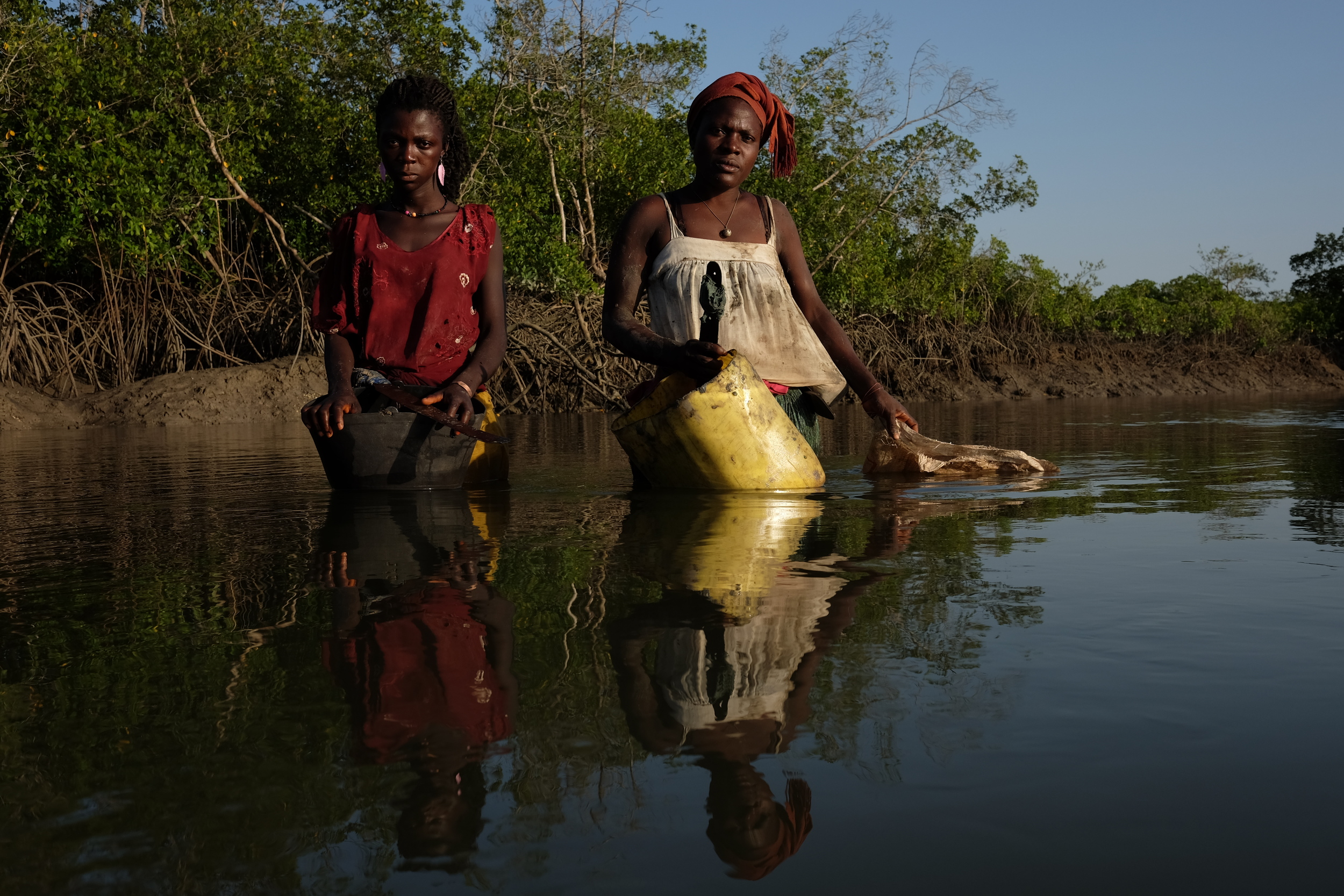














Teresa Jaoquim surveys the land as she decides which point in the mangroves to search for oysters on Bubaque Island in Guinea Bissau. The market where she sells the oysters is more than an hour's walk from her village, Anacamona. The oysters can sell for anywhere from 100 CFA ($.18 USD) to 500 CFA ($.90 USD) each, or around $3 USD for an entire bucket. Besides the local markets, the women from Anacamona also sell the oysters to local hotels on Bubaque Island, which is a tourist destination for sports fishermen.

Ndra Lopes, 22, chops at the oysters. According to the women from Anacamona, the oysters are plentiful in the area and they haven't had troubles with shortages. The Bijagós archipelagos is internationally recognized as a UNESCO biosphere reserve for its unique array of plant and animal diversity.

Women from Anacamona village on Bubaque Island in Guinea Bissau walk to the islands mangroves to harvest oysters. The women usually venture out in groups of two to three to gather the oysters, and they know what time of day to go the mangroves by watching certain species of birds on the island – when they see the birds flying overhead they say they know the tide is low and the right time to harvest the oysters. November 2014.

In 2013, per capita gross national income was estimated at about $520 in Guinea Bissau, according to the World Bank. The poverty rate has risen by 10% since 2002, and extreme poverty has grown by 23% since 2002.

The women also often cut themselves on the sharp machetes used to hack the oysters off the branches, and most of them work barefoot so the rocks and shells are painful to walk on as they go about their work.

Ndra Lopes, 22, uses the money she earns from harvesting oysters to help support her 2-year-old son, Fabio. Ndra says she can swim “a little,” but often many of the women cannot swim, which makes the business even riskier.

The oysters can sell for anywhere from 100 CFA ($.18 USD) to 500 CFA ($.90 USD) each, or around $3 USD for an entire bucket. Besides the local markets, the women from Anacamona village also sell the oysters to local hotels on Bubaque Island, which is a tourist destination for sports fishermen.

Ndra Lopes and Teresa Jaoquim pose while gathering oysters in the mangroves on Bubaque Island. Ndra, who is 22, goes to a local high school most afternoons after she either works in the rice fields or finishes gathering oysters. She tries to fit in studying time at night, using a solar lamp, as there is no electricity in her village.

After spotting certain local birds flying overhead, a signal the tide is low, the women walk through heavy brush to get to muddy fields. They then wade through the fields with bare feet. They know how to spot where oysters will be residing based on the presence of local plants. The women use their machetes to hack the oysters loose from branches, or dig through the mud to uncover their find.

Teresa Jaoquim surveys the land as she decides which point in the mangroves to search for oysters. The market where she sells the oysters is more than an hour's walk from her village, Anacamona. The oysters can sell for anywhere from 100 CFA ($.18 USD) to 500 CFA ($.90 USD) each, or around $3 USD for an entire bucket. Besides the local markets, the women from Anacamona village also sell the oysters to local hotels on Bubaque Island, which is a tourist destination for sports fishermen

Twenty-four year-old Tania Antonio Eugenio Carunbe digs in the mud to find oysters. Carunbe has one son and lives in Anacamona village on Bubaque Island.

Teresa Jaoquim surveys the land as she decides which point in the mangroves to search for oysters. The market where she sells the oysters is more than an hour's walk from her village, Anacamona. The oysters can sell for anywhere from 100 CFA ($.18 USD) to 500 CFA ($.90 USD) each, or around $3 USD for an entire bucket. Besides the local markets, the women from Anacamona village also sell the oysters to local hotels on Bubaque Island, which is a tourist destination for sports fishermen

A group of women from Anacamona wash oysters after spending hours in the mangroves gathering them. Most of the women fill their entire buckets when they go out in search of the oysters.